hood release CHEVROLET TRACKER 2003 2.G Owners Manual
[x] Cancel search | Manufacturer: CHEVROLET, Model Year: 2003, Model line: TRACKER, Model: CHEVROLET TRACKER 2003 2.GPages: 372, PDF Size: 2.65 MB
Page 115 of 372
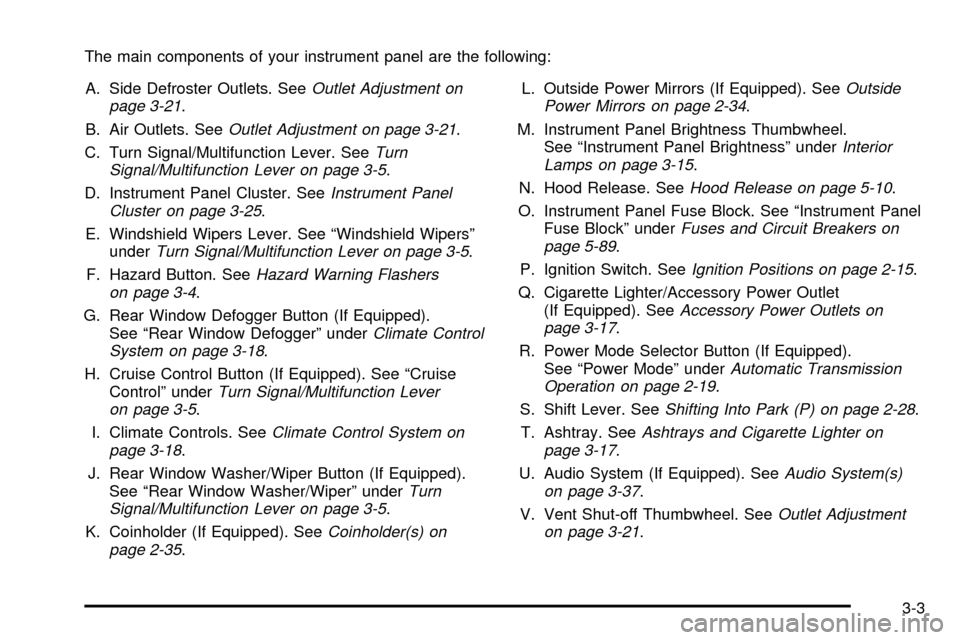
The main components of your instrument panel are the following:
A. Side Defroster Outlets. See
Outlet Adjustment on
page 3-21.
B. Air Outlets. See
Outlet Adjustment on page 3-21.
C. Turn Signal/Multifunction Lever. See
Turn
Signal/Multifunction Lever on page 3-5.
D. Instrument Panel Cluster. See
Instrument Panel
Cluster on page 3-25.
E. Windshield Wipers Lever. See ªWindshield Wipersº
under
Turn Signal/Multifunction Lever on page 3-5.
F. Hazard Button. See
Hazard Warning Flashers
on page 3-4.
G. Rear Window Defogger Button (If Equipped).
See ªRear Window Defoggerº under
Climate Control
System on page 3-18.
H. Cruise Control Button (If Equipped). See ªCruise
Controlº under
Turn Signal/Multifunction Lever
on page 3-5.
I. Climate Controls. See
Climate Control System on
page 3-18.
J. Rear Window Washer/Wiper Button (If Equipped).
See ªRear Window Washer/Wiperº under
Turn
Signal/Multifunction Lever on page 3-5.
K. Coinholder (If Equipped). See
Coinholder(s) on
page 2-35.L. Outside Power Mirrors (If Equipped). See
Outside
Power Mirrors on page 2-34.
M. Instrument Panel Brightness Thumbwheel.
See ªInstrument Panel Brightnessº under
Interior
Lamps on page 3-15.
N. Hood Release. See
Hood Release on page 5-10.
O. Instrument Panel Fuse Block. See ªInstrument Panel
Fuse Blockº under
Fuses and Circuit Breakers on
page 5-89.
P. Ignition Switch. See
Ignition Positions on page 2-15.
Q. Cigarette Lighter/Accessory Power Outlet
(If Equipped). See
Accessory Power Outlets on
page 3-17.
R. Power Mode Selector Button (If Equipped).
See ªPower Modeº under
Automatic Transmission
Operation on page 2-19.
S. Shift Lever. See
Shifting Into Park (P) on page 2-28.
T. Ashtray. See
Ashtrays and Cigarette Lighter on
page 3-17.
U. Audio System (If Equipped). See
Audio System(s)
on page 3-37.
V. Vent Shut-off Thumbwheel. See
Outlet Adjustment
on page 3-21.
3-3
Page 217 of 372
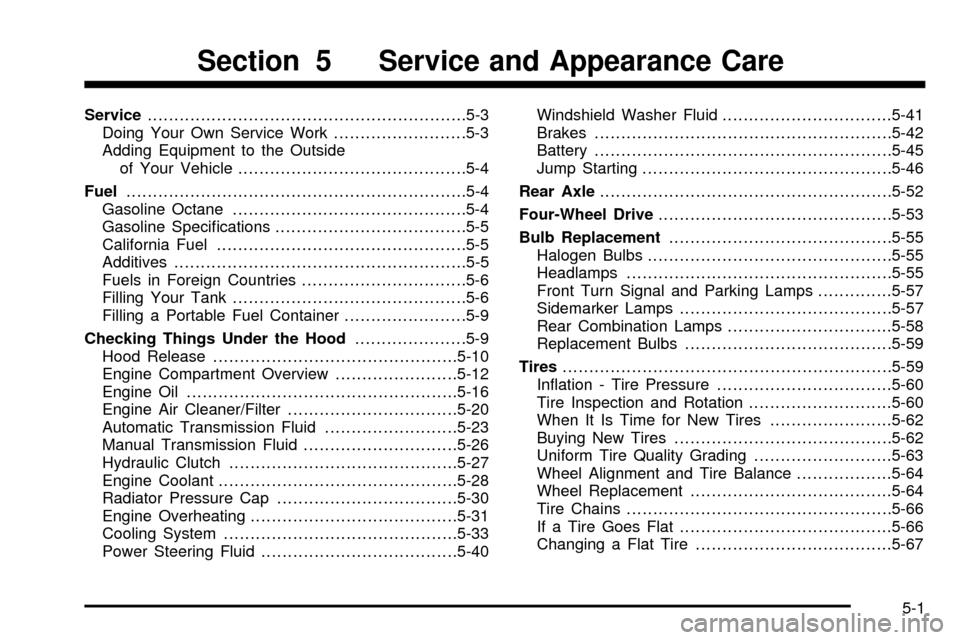
Service............................................................5-3
Doing Your Own Service Work.........................5-3
Adding Equipment to the Outside
of Your Vehicle...........................................5-4
Fuel................................................................5-4
Gasoline Octane............................................5-4
Gasoline Speci®cations....................................5-5
California Fuel...............................................5-5
Additives.......................................................5-5
Fuels in Foreign Countries...............................5-6
Filling Your Tank............................................5-6
Filling a Portable Fuel Container.......................5-9
Checking Things Under the Hood.....................5-9
Hood Release..............................................5-10
Engine Compartment Overview.......................5-12
Engine Oil...................................................5-16
Engine Air Cleaner/Filter................................5-20
Automatic Transmission Fluid.........................5-23
Manual Transmission Fluid.............................5-26
Hydraulic Clutch...........................................5-27
Engine Coolant.............................................5-28
Radiator Pressure Cap..................................5-30
Engine Overheating.......................................5-31
Cooling System............................................5-33
Power Steering Fluid.....................................5-40Windshield Washer Fluid................................5-41
Brakes........................................................5-42
Battery........................................................5-45
Jump Starting...............................................5-46
Rear Axle.......................................................5-52
Four-Wheel Drive............................................5-53
Bulb Replacement..........................................5-55
Halogen Bulbs..............................................5-55
Headlamps..................................................5-55
Front Turn Signal and Parking Lamps..............5-57
Sidemarker Lamps........................................5-57
Rear Combination Lamps...............................5-58
Replacement Bulbs.......................................5-59
Tires..............................................................5-59
In¯ation - Tire Pressure.................................5-60
Tire Inspection and Rotation...........................5-60
When It Is Time for New Tires.......................5-62
Buying New Tires.........................................5-62
Uniform Tire Quality Grading..........................5-63
Wheel Alignment and Tire Balance..................5-64
Wheel Replacement......................................5-64
Tire Chains..................................................5-66
If a Tire Goes Flat........................................5-66
Changing a Flat Tire.....................................5-67
Section 5 Service and Appearance Care
5-1
Page 225 of 372
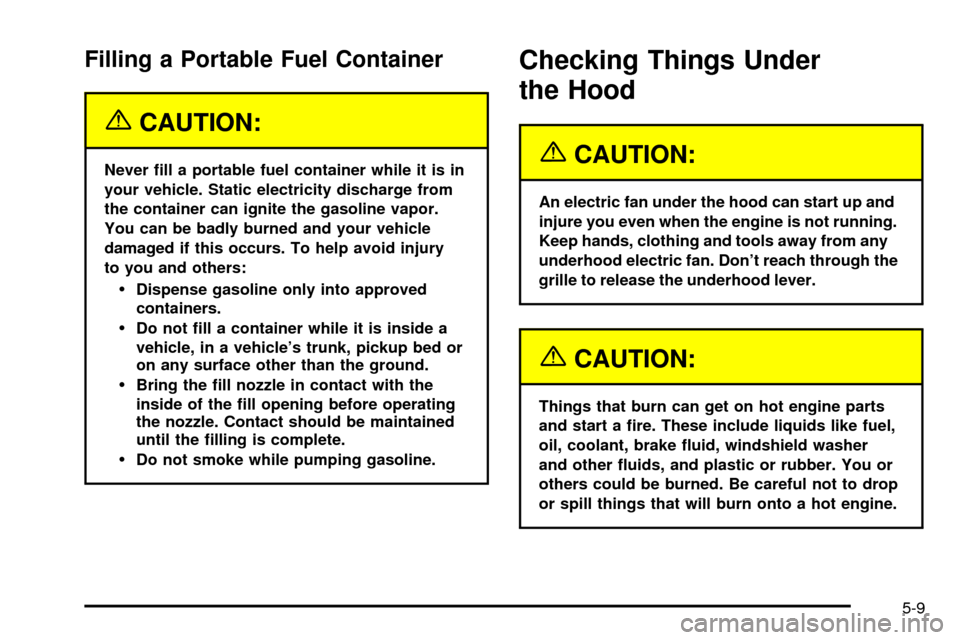
Filling a Portable Fuel Container
{CAUTION:
Never ®ll a portable fuel container while it is in
your vehicle. Static electricity discharge from
the container can ignite the gasoline vapor.
You can be badly burned and your vehicle
damaged if this occurs. To help avoid injury
to you and others:
·Dispense gasoline only into approved
containers.
·Do not ®ll a container while it is inside a
vehicle, in a vehicle's trunk, pickup bed or
on any surface other than the ground.
·Bring the ®ll nozzle in contact with the
inside of the ®ll opening before operating
the nozzle. Contact should be maintained
until the ®lling is complete.
·Do not smoke while pumping gasoline.
Checking Things Under
the Hood
{CAUTION:
An electric fan under the hood can start up and
injure you even when the engine is not running.
Keep hands, clothing and tools away from any
underhood electric fan. Don't reach through the
grille to release the underhood lever.
{CAUTION:
Things that burn can get on hot engine parts
and start a ®re. These include liquids like fuel,
oil, coolant, brake ¯uid, windshield washer
and other ¯uids, and plastic or rubber. You or
others could be burned. Be careful not to drop
or spill things that will burn onto a hot engine.
5-9
Page 226 of 372
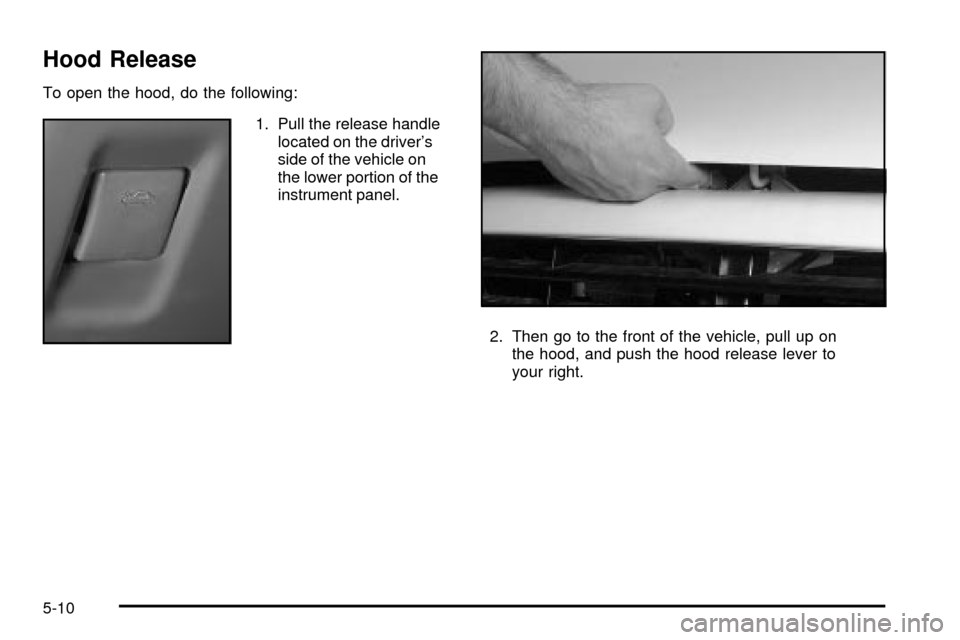
Hood Release
To open the hood, do the following:
1. Pull the release handle
located on the driver's
side of the vehicle on
the lower portion of the
instrument panel.
2. Then go to the front of the vehicle, pull up on
the hood, and push the hood release lever to
your right.
5-10
Page 227 of 372
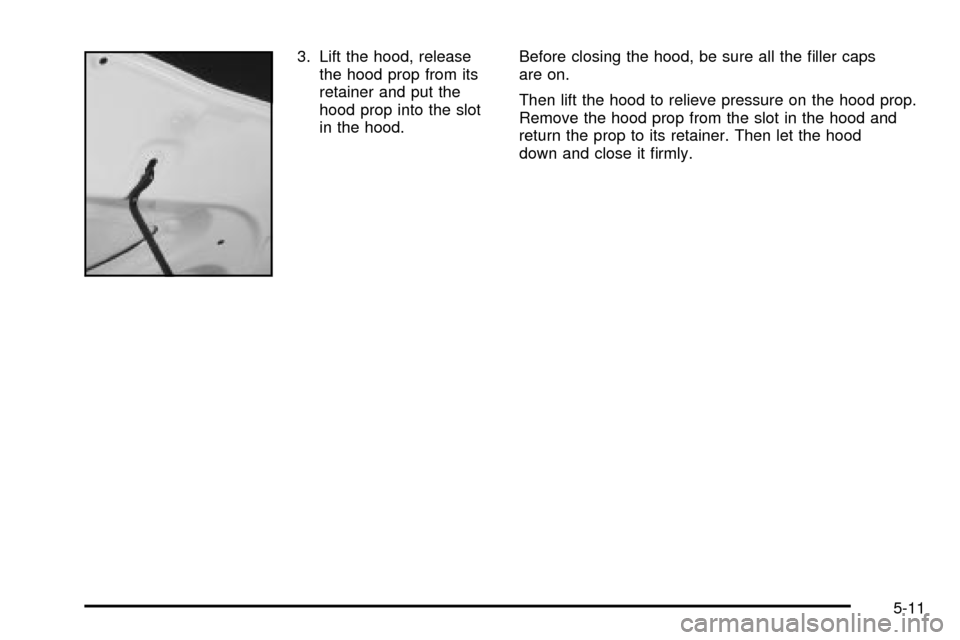
3. Lift the hood, release
the hood prop from its
retainer and put the
hood prop into the slot
in the hood.Before closing the hood, be sure all the ®ller caps
are on.
Then lift the hood to relieve pressure on the hood prop.
Remove the hood prop from the slot in the hood and
return the prop to its retainer. Then let the hood
down and close it ®rmly.
5-11
Page 249 of 372
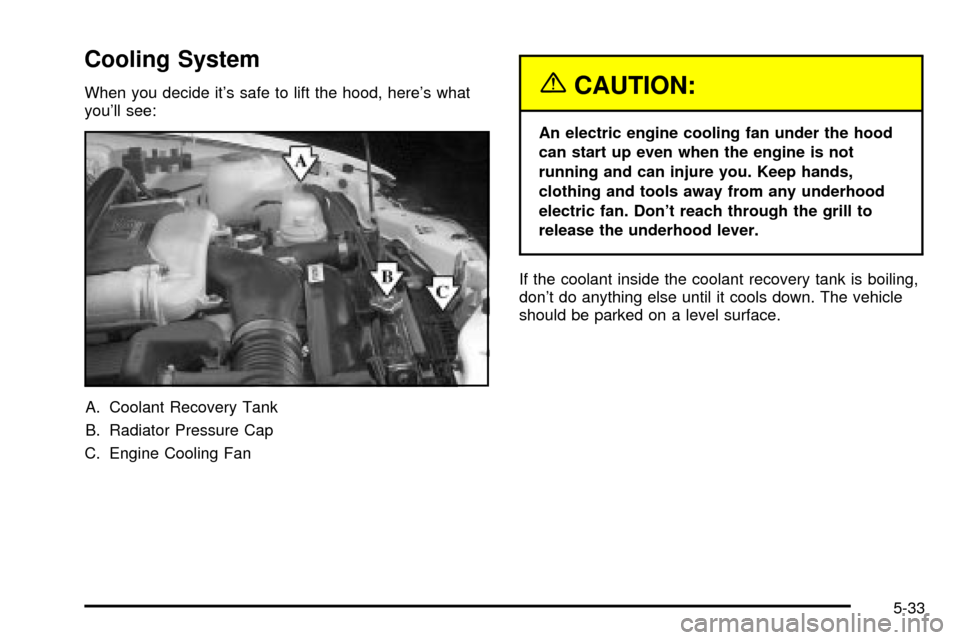
Cooling System
When you decide it's safe to lift the hood, here's what
you'll see:
A. Coolant Recovery Tank
B. Radiator Pressure Cap
C. Engine Cooling Fan{CAUTION:
An electric engine cooling fan under the hood
can start up even when the engine is not
running and can injure you. Keep hands,
clothing and tools away from any underhood
electric fan. Don't reach through the grill to
release the underhood lever.
If the coolant inside the coolant recovery tank is boiling,
don't do anything else until it cools down. The vehicle
should be parked on a level surface.
5-33
Page 272 of 372
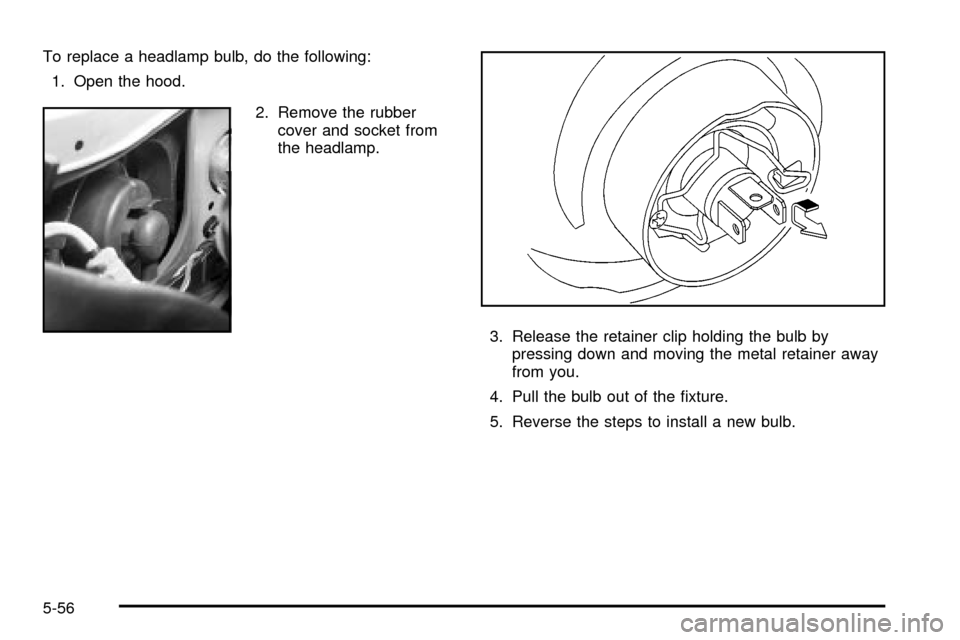
To replace a headlamp bulb, do the following:
1. Open the hood.
2. Remove the rubber
cover and socket from
the headlamp.
3. Release the retainer clip holding the bulb by
pressing down and moving the metal retainer away
from you.
4. Pull the bulb out of the ®xture.
5. Reverse the steps to install a new bulb.
5-56
Page 336 of 372
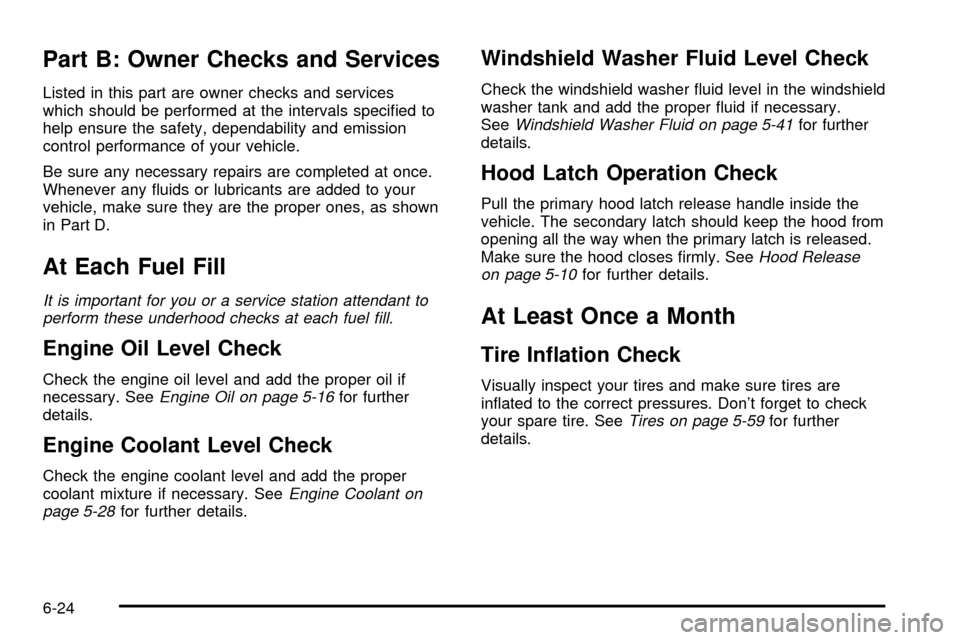
Part B: Owner Checks and Services
Listed in this part are owner checks and services
which should be performed at the intervals speci®ed to
help ensure the safety, dependability and emission
control performance of your vehicle.
Be sure any necessary repairs are completed at once.
Whenever any ¯uids or lubricants are added to your
vehicle, make sure they are the proper ones, as shown
in Part D.
At Each Fuel Fill
It is important for you or a service station attendant to
perform these underhood checks at each fuel ®ll.
Engine Oil Level Check
Check the engine oil level and add the proper oil if
necessary. SeeEngine Oil on page 5-16for further
details.
Engine Coolant Level Check
Check the engine coolant level and add the proper
coolant mixture if necessary. SeeEngine Coolant on
page 5-28for further details.
Windshield Washer Fluid Level Check
Check the windshield washer ¯uid level in the windshield
washer tank and add the proper ¯uid if necessary.
See
Windshield Washer Fluid on page 5-41for further
details.
Hood Latch Operation Check
Pull the primary hood latch release handle inside the
vehicle. The secondary latch should keep the hood from
opening all the way when the primary latch is released.
Make sure the hood closes ®rmly. See
Hood Release
on page 5-10for further details.
At Least Once a Month
Tire In¯ation Check
Visually inspect your tires and make sure tires are
in¯ated to the correct pressures. Don't forget to check
your spare tire. See
Tires on page 5-59for further
details.
6-24
Page 343 of 372
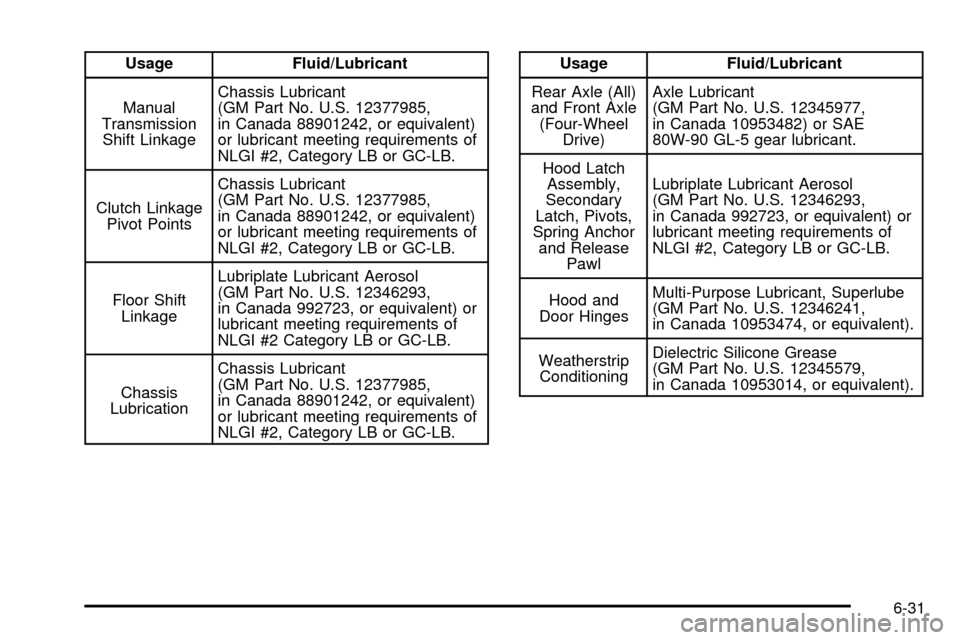
Usage Fluid/Lubricant
Manual
Transmission
Shift LinkageChassis Lubricant
(GM Part No. U.S. 12377985,
in Canada 88901242, or equivalent)
or lubricant meeting requirements of
NLGI #2, Category LB or GC-LB.
Clutch Linkage
Pivot PointsChassis Lubricant
(GM Part No. U.S. 12377985,
in Canada 88901242, or equivalent)
or lubricant meeting requirements of
NLGI #2, Category LB or GC-LB.
Floor Shift
LinkageLubriplate Lubricant Aerosol
(GM Part No. U.S. 12346293,
in Canada 992723, or equivalent) or
lubricant meeting requirements of
NLGI #2 Category LB or GC-LB.
Chassis
LubricationChassis Lubricant
(GM Part No. U.S. 12377985,
in Canada 88901242, or equivalent)
or lubricant meeting requirements of
NLGI #2, Category LB or GC-LB.Usage Fluid/Lubricant
Rear Axle (All)
and Front Axle
(Four-Wheel
Drive)Axle Lubricant
(GM Part No. U.S. 12345977,
in Canada 10953482) or SAE
80W-90 GL-5 gear lubricant.
Hood Latch
Assembly,
Secondary
Latch, Pivots,
Spring Anchor
and Release
PawlLubriplate Lubricant Aerosol
(GM Part No. U.S. 12346293,
in Canada 992723, or equivalent) or
lubricant meeting requirements of
NLGI #2, Category LB or GC-LB.
Hood and
Door HingesMulti-Purpose Lubricant, Superlube
(GM Part No. U.S. 12346241,
in Canada 10953474, or equivalent).
Weatherstrip
ConditioningDielectric Silicone Grease
(GM Part No. U.S. 12345579,
in Canada 10953014, or equivalent).
6-31
Page 364 of 372
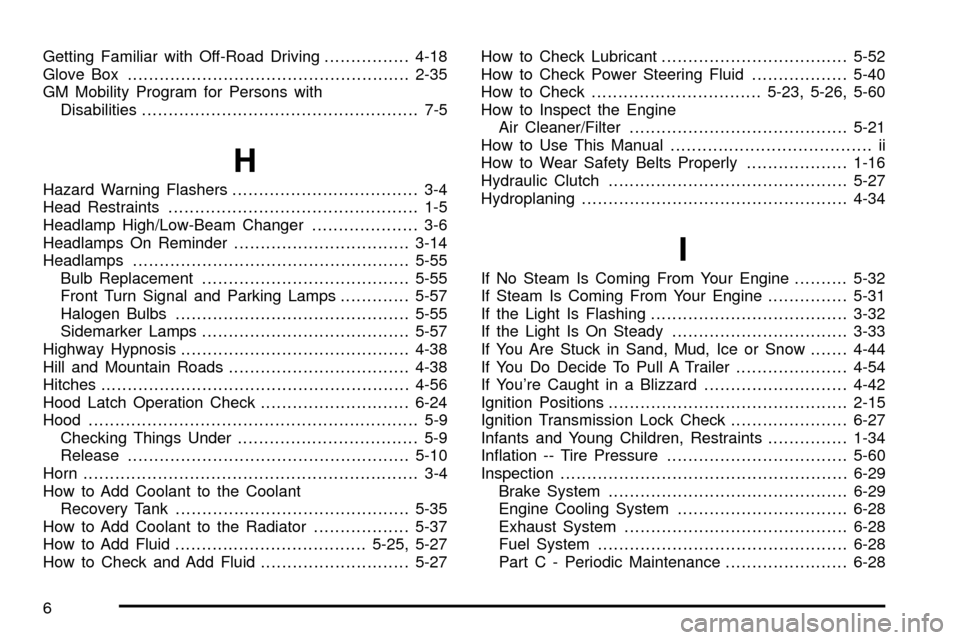
Getting Familiar with Off-Road Driving................4-18
Glove Box.....................................................2-35
GM Mobility Program for Persons with
Disabilities.................................................... 7-5
H
Hazard Warning Flashers................................... 3-4
Head Restraints............................................... 1-5
Headlamp High/Low-Beam Changer.................... 3-6
Headlamps On Reminder.................................3-14
Headlamps....................................................5-55
Bulb Replacement.......................................5-55
Front Turn Signal and Parking Lamps.............5-57
Halogen Bulbs............................................5-55
Sidemarker Lamps.......................................5-57
Highway Hypnosis...........................................4-38
Hill and Mountain Roads..................................4-38
Hitches..........................................................4-56
Hood Latch Operation Check............................6-24
Hood.............................................................. 5-9
Checking Things Under.................................. 5-9
Release.....................................................5-10
Horn............................................................... 3-4
How to Add Coolant to the Coolant
Recovery Tank............................................5-35
How to Add Coolant to the Radiator..................5-37
How to Add Fluid....................................5-25, 5-27
How to Check and Add Fluid............................5-27How to Check Lubricant...................................5-52
How to Check Power Steering Fluid..................5-40
How to Check................................5-23, 5-26, 5-60
How to Inspect the Engine
Air Cleaner/Filter.........................................5-21
How to Use This Manual...................................... ii
How to Wear Safety Belts Properly...................1-16
Hydraulic Clutch.............................................5-27
Hydroplaning..................................................4-34
I
If No Steam Is Coming From Your Engine..........5-32
If Steam Is Coming From Your Engine...............5-31
If the Light Is Flashing.....................................3-32
If the Light Is On Steady.................................3-33
If You Are Stuck in Sand, Mud, Ice or Snow.......4-44
If You Do Decide To Pull A Trailer.....................4-54
If You're Caught in a Blizzard...........................4-42
Ignition Positions.............................................2-15
Ignition Transmission Lock Check......................6-27
Infants and Young Children, Restraints...............1-34
In¯ation -- Tire Pressure..................................5-60
Inspection......................................................6-29
Brake System.............................................6-29
Engine Cooling System................................6-28
Exhaust System..........................................6-28
Fuel System...............................................6-28
Part C - Periodic Maintenance.......................6-28
6